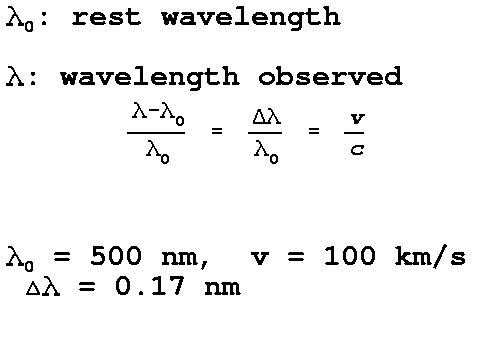
Electromagnetic radiation: electric and magnetic fields traveling through space.
Travels at c = 3 x 105 km/s (in vacuum)
Light a type of e-m radiation
Acts like a wave, and a particle
Wavelength: distance between two successive wavecrests. Any value greater than 0.
Frequency (f): number of wavecrests that pass per second.
For electromagnetic radiation:

Short wavelength - high frequency
Long wavelength - low frequency
Visible light:
300-800 nm (nanometer)
1 nm = 10-9 m
Blue light 400 nm
Red light 700 nm
Spectrum: arrangement of electromagnetic radiation by wavelength
Regions of the spectrum:
Name Wavelength
High energy
Gamma rays 10-12 m (10-3nm)
X-rays 10-2nm - 10nm
Ultraviolet 10nm - 300nm Visible 300nm - 800, 1000 nm Infrared 1000 nm - 106nm (0.1 cm) Radio longer than 0.1 cm
(includes microwave) Photon: particle of light Amount of energy depends on wavelength Shorter wavelengths - higher energy (Blue light, x-rays) Longer wavelengths - lower
energy (Red light, radio
waves) Refraction: the bending of electromagnetic
radiation as it passes from one transparent medium to another Prism: different wavelengths
refracted different amounts Light spread out by
wavelength (color), producing spectrum Types of Spectra (Kirchhoff's Laws) continuous spectrum - hot,
dense body absorption spectrum - continuous spectrum
behind cool gas cloud emission spectrum - hot,
low density gas cloud Elements identified by
patterns of lines Atoms Nucleus: 0.0000016 nm Nucleus: protons (+) neutrons (0) Electron Cloud: 0.1-0.5 nm Bohr Model: electrons exist only in certain orbits Orbits correspond to electron energy (energy levels) Energy state of electron is raised if add energy. Must add energy equal to energy difference of two energy levels Only photons of
particular energies
(wavelengths) can be
absorbed by atom Each element has its own
set of energy levels, absorbs only particular photons Atoms return to lowest energy state by emitting photons corresponding to energy difference of two levels Doppler effect: change in
wavelength of emitted light because of motion towards or away from earth. Motion towards earth, lines
shift to shorter wavelength, 'Blueshift' Motion away from earth, lines shifted to longer wavelength, 'Redshift'
electrons (-)

Measurement of radial velocities only
Telescopes
Refracting telescopes - lenses
Telescopes have 2 lenses
Objective lens
Eyepiece
Problems with refracting telescopes
Reflecting telescopes - use mirrors - glass coated with aluminum
Primary mirror (objective mirror): focuses image at prime focus.
Various arrangements of secondary mirrors
Modern telescopes
a. Segmented mirrors, e.g. Keck telescope
b. Spin-cast mirrors - honeycombed glass
c. Floppy mirrors - thin - (computer controlled)
d. Adaptive optics: nullify effects of atmosphere on light passing through it.
Seeing: blurring of light as it passes through the atmosphere
Telescopes in space avoid problems with seeing
Adaptive optics measures bright star to determine distortion, adjusts a deformable mirror to correct for the distortion.
Telescope Parameters

Light gathering power proportional to diameter squared.
Resolving power (R.P.) - angular distance between 2 stars can just separate in telescope.

Radio Telescopes
reflecting 'dishes' (antenna)
Resolving power (R.P.)

Diam. = 25 meter
R.P. = 104 arcsec = 2.8 deg.
Want a large diameter!!
E.g. 3 arcsec resolution at 21 cm requires 18 km telescope!!!
Radio Interferometer
> 2 radio telescopes linked together
R.P. equivalent to a telescope with diameter equal to distance between telescopes
Very Large Array (VLA)
27 telescopes
Simulates radio telescope >30 km in diameter
Very Long Baseline Interferometer (VLBI)
VLB Array - 10 telescopes Virgin Islands to Hawaii
Space Astronomy - Why Bother?
1. Detect wavelengths that don't penetrate to earth's surface.
2. Get above turbulence in earth's atmosphere
Infrared (IR) Astronomy
Dry mountain tops
Balloons, SOFIA - 747 - 2005
IRAS - Infrared Astronomy Satellite
Telescope cooled to near 0 deg.
ISO - Infrared Space Observatory (European)
SIRTF (Space Infrared Telescope Facility) 2003
Ultraviolet Astronomy (UV)
< 300 nm (nm = 10-9 m) absorbed by ozone
Must observe from space
Rockets
Satellites
X-ray Astronomy
Violent events
10 nm - 0.01 nm
balloons, rockets, satellites
CHANDRA - currently in orbit
Gamma-Ray Astronomy
Satellites
'bursters'
active galactic nuclei
Cosmic Rays
energetic particles - protons, electrons, positrons, other atomic nuclei
detected from satellites
'showers' detected on ground
source not well-understood
Neutrinos
particle with tiny mass, no electric charge, travels at speeds very close to c
generated in nuclear reactions in stars, at origin of universe
Difficult to detect - don't interact with ordinary matter
Detectors:
Large tanks of chlorine or very pure water